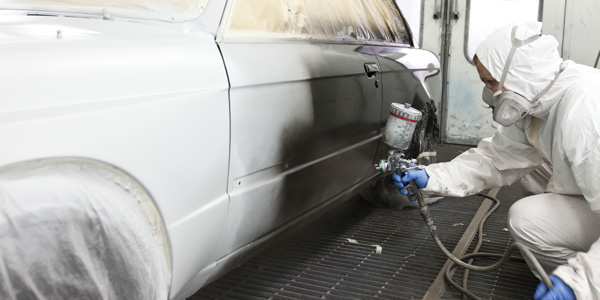
“Paint it, black.”
Henry Ford is credited with this infamous (if somewhat misused) quote regarding the Model T and its signature paint job. While it’s true that from 1913 to 1925, the Tin Lizzie was only produced in black, 1908-1912 and 1926-1927 models actually were available in a wide range of colors.
Today, the automotive refinish category is much more complex than simply painting it black, and the options available to our customers are as confusing as they are colorful. From a DIYer seeking a simple touchup to a professional body shop ordering paint for an overall refinish, all of our customers have different needs. Regardless of their level of expertise, the one thing that all of our “paint customers” have in common is that they want the finished product to match!
The first step in matching an existing color is determining the manufacturer’s paint code for the color you’re attempting to match. Typically, these alpha-numeric codes are found on a decal or tag along with other vehicle option codes in one of four locations:
- The door or door jamb (driver’s or passenger side, depending on the manufacturer)
- Under the hood (on the firewall, radiator support or strut tower)
- In the trunk (on the underside of the decklid, in the spare-tire area or under the carpet/mat)
- In the glove compartment (primarily in GM trucks and SUVs)
The paint code format will vary by manufacturer, but for most vehicles manufactured in the past 20 years, these formats will match the following:
- Chrysler: Three-digit code, beginning with “P” (PXR, PW7, PS2, etc.). Trim colors may begin with “Q”.
- Ford: Two letters, or a letter and number (AQ, CX, G9, etc.).
- GM: Four-digit code (8554, 929L, 800J, etc.), often seen with a “WA” or “BC/CC” prefix.
- BMW: Three-digit code (300, 475, A61, etc.), with the color name written in German.
- Honda: Four- to six-digit code (B92P, NH578, YR571P, etc.), first letter indicating color family.
- Hyundai: Two- or three-digit code (2Z, AA, MBK, etc.). Kia codes are similar, and often share color codes.
- Mazda: Three-digit code (14L, 27A, 39T, etc.), or may share color/code with Ford (UA, YZ, G2, etc.).
- Nissan: Three-digit code (A20, K50, Z5K, etc.), first letter indicating color family.
- Subaru: Three-digit code (01X, 286, 0A6, etc.). For two-tone, code represents the color combination.
- Toyota: Three-digit code (068, 4Q2, 8R3, etc.). For two-tone, code represents the color combination.
- Volvo: Three-digit numeric code (019, 455, 702, etc.), followed by a dash and two more digits.
- VW: Four-digit code beginning with “L” (L041, LC9A, LB7W, etc.).
If you have access to a color chip book, these codes (and any alternate codes used by the manufacturer) can be compared to the vehicle decal or tag for verification, and to determine if the current paint color matches the sample chip in the color book. When paint codes are located on removable parts such as a door, decklid or spare-tire cover, it also is important to verify that the part is original to the vehicle, and that the options tag matches the VIN.
Chip books also are a great tool for helping your customer decide on an entirely new color for an overall paint job, or to determine the correct paint code for an unknown color if the original decal or tag is missing or unreadable. When attempting to match a color from the chip book, or selecting a new color with your customer, be sure to view the color chips in natural light. Fluorescent lighting is the most common light source in a parts store, but it can alter our perception of colors. Weather permitting, your best bet is to take the chip book outside to see what that color will look like in broad daylight, and to compare it to the existing color.
As parts specialists, customers expect us to know at least a little bit about all things automotive, including refinish products. Today’s customers have more choices, and much higher expectations than they did in Henry Ford’s day. Telling folks to “paint it, black” might have worked for Henry Ford (and Mick Jagger), but it just doesn’t cut it in today’s market.








